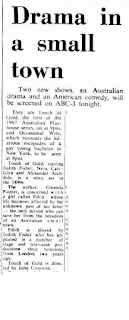Second season episode of Australian Playhouse.
Premise
A story centered around a hospital waiting room. A 19 year old man, Robert, arrives, insisting he is sick but the nurse refuses to see him. An older man arrives. The two men have an argument. It is implied the Old Man is the father of Robret.
Robert knocks out the old man and leaves. A nurse takes the older man away.
Cast
- Ben Gabriel as Old Man
- Martin Harris as Young Man (Robert Smith)
- Shirley Cameron as Sister
- Bowen Llewellyn
- Ed Nelson
Production
It was directed by Storry Walton. John Croyston wrote the script.
According to ABC records it was shot on 1 April 1967.
A full copy of the script is at the NAA see here.
Technical producer - Les Weldon. Designer - Jack Montgomery. Producer and director - Storry Walton.
I asked Storry Walton about this and in an email of 16 August 2021 he said:
I collaborated as producer and director with John Croyston in four of his television screenplays for the ABC - Casualty, Limbo, Construction and The Runaway.
They were each produced in the hectic and creative period of the late 60s when television was new, its creative parameters free, and the ABC open to experiment in form and content. And John and I were among the first cohort of writers, producers and directors, mostly young, ready to take up the opportunity to exploit that edgy space. We did so with the unswerving encouragement of Neil Hutchison, Head of Drama and Features, and later David Goddard.
My production of the script looks very staid by today’s standards (even perhaps by the standards of the day), and rather lacking in the subtleties that are there in the script to reveal. However, I think the show is useful as an example of a tele-play that — while it would never otherwise have seen the light of day in a ratings-led, populist- leaning broadcasting environment — represents the kind of intellectual and imaginative output that a public broadcaster like the ABC was bound to produce - and did! Among its traditional narrative-based plays there was always room for experiment. Casualty is one such production. It is non-naturalistic; characterisation is limited but symbolic as in a medieval morality play; and its style is certainly undramatic.
John drew on his Catholic background to set his play in a bare white hospital waiting room which is in fact the waiting-room between life and death. It is supervised by a nurse in the nun-like veil of the day - St. Peter as a woman in one moment, and tender lover at another. The play revolves around the acceptance of death by the old man who comes to the waiting room hard-worn by life and homeless, ready for transition, and the belligerent incomprehension of the young man as to why here is there. He is sent back as too immature for the reward of death.
Looking at the play today, I am reminded what a fine, thoughtful screen actor Ben Gabriel was. Such presence and understanding of the screen.
I am reminded also what a special device the close-up was in those days. When television sets were quite small, a forehead to chin shot (known as a bcu or big close up) was about life-size on a home tv set in a sitting room. Its intimacy was prized, and I used it very selectively for maximum impact. Ben Gabriel and Shirley Cameron use its intimacy so well in this case.
Les Weldon was one of the wonderfully responsive ABC technical producers/ lighting supervisors (called TPs) of the day. He was one who was prepared to disobey the rigid technical rules imposed in those early days of the image orthicon camera tubes which required in every image - that is, in every shot of a drama, a required balance of tones from white through grey to black - it was called the grey scale and every camera on the studio floor a had its own control technician in the control-room to ensure obedience to the rules. Every image had to have a percentage of so much white, so much grey and so much black - and the Technical Producer could theoretically override a director’s creative lighting wishes.
There’s an awful lot of unapproved white in Casualty. I wanted, not an ethereal feel, but a sense of white limbo. Rules required all flattage (walls) to be painted in tones of grey. Breaking the rules therefore, Les Weldon collaborated with designer Jack Montgomery to paint them white. The nurse in her stark white veil is photographed against the stark white walls (not officially approved) and the final shot is a study in white. No cameras were hurt in the production, and none of us was cast into professional oblivion. So it worked. I took white limbo even further in another of John’s plays entitled (guess what?) Limbo.
Reception
A reviewer in The Age called it "a waste of viewing time" with "pathetic dialogue".
Another writer in that paper called it "stylised".
The Sydney Morning Herald complained about Croyston's "airy fairy artsy fartsy script". The Sunday edition of that paper called it a "weirdie".





















































